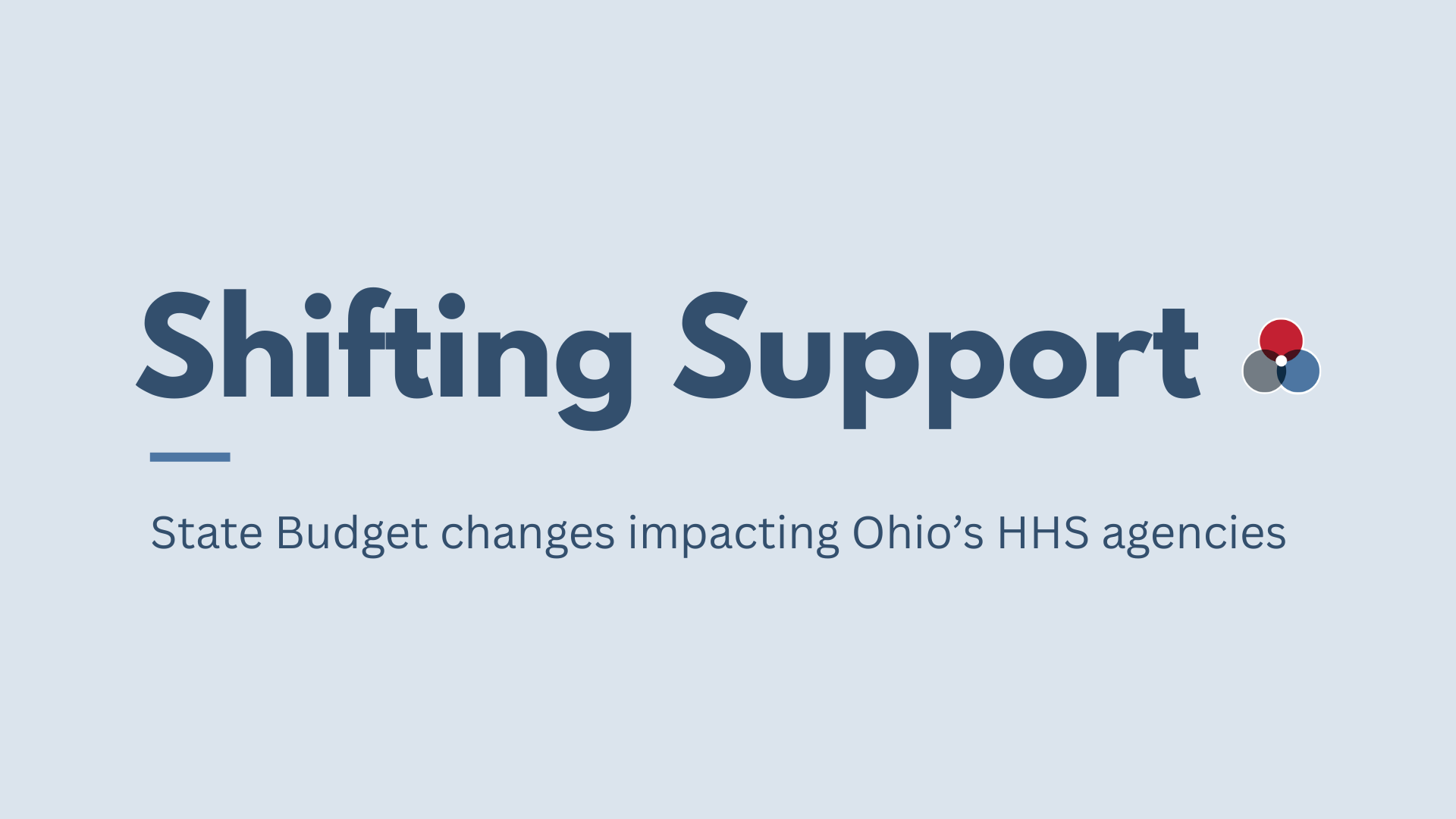Introduction
In Ohio, social service programs are state sponsored and county administered. Each county government has latitude to design programs, collect and allocate funds, and target resources within the limits of state and federal regulations. Ohio communities also rely on locally-generated funds to support health and social services to a greater degree than most other states do. The amount and purpose of local property tax levy funding for health and social services determines the type and level of services that may be available, and varies from county to county.
Ohio communities also rely on locally-generated funds to support health and social services to a greater degree than most other states do.
While all 50 states have property taxes, Ohio is unique in the degree to which we rely on local support of health and social service programs. For example, more than half of all funds generated at the local level in the United States for services for people with developmental disabilities are raised in Ohio.[1] Property owners were charged nearly $2.5 billion in county property taxes to support health and social services in 2018 in Ohio. In that same year, 654 separate active health and social service levies were part of Ohio property owner’s tax bills. This does not include the substantial number of municipal levies for human service purposes, nor does it include any sales taxes that support human services.
Ohio is unique in the degree to which we rely on local support of health and social service programs.
This analysis utilizes the latest data available from the Ohio Department of Taxation[2] to examine the mix of health and social service levies in each of Ohio’s 88 counties. We narrowed our examination to county and special district levies, using levy name or jurisdiction name to identify levies that support health and social services. Using this data source enabled us to conduct a consistent examination for counties across Ohio. However, it is important to note that the amount charged in property tax levies is assumed to be higher than the actual amount that is able to be collected. Therefore, the amount charged should be considered a high estimate of what property tax revenue is available in a county.
Health and social service levies by county
It is not surprising that levies in large, urban counties produce more funding for health and social services. The five largest counties by population accounted for more than half of the $2.5 billion charged in property taxes for health and human services in 2018. At more than $438 million, the many levies in Franklin County generate the greatest total amount of funding for health and human services in the state. Cuyahoga County is a close second at $347 million charged for two general health and human service levies and the developmental disabilities levies, followed by Hamilton County ($261 million), Montgomery County ($135 million) and Summit County ($115 million).
Examining levies on a per capita basis allows for a more even examination of the relative resources that are available to support health and social services in a given county. Levies in Harrison County have the potential to generate nearly $360 for every county resident,[3] the highest in the state. On the other hand, Brown County’s levies generate less than $43 per county resident. The table below shows the 10 highest and the 10 lowest counties in terms of per capita health and human service property tax levies charged. The state average is around $212 per person, and the median is just under $155.
Total HHS Property Taxes Charged per Capita, 2018[table id=98 /]
The amount charged by any levy is a function of property values and the millage rate approved by voters. Property tax rates are stated in mills, and one mill equals $1 of tax for every $1,000 in assessed value. The total millage charged for all health and social service levies in 2018 ranged from 2.78 mills in Lawrence County to 17.88 mills in Hamilton County, with a median of 7.9 mills.
A full listing of all counties, the types of levies and total amount charged in each in 2018 is in the Appendix.
Health and social service levies by purpose
Health and social service levies fall into one of six categories, which are described in greater detail below. All 88 counties have at least one property tax levy that supports services for people with intellectual or developmental disabilities, all but a handful of counties have levies that provide funds for behavioral health boards, and 71 counties have a senior services levy. Levies which pay for public health services or support public hospitals are less common, and just more than half (46) of counties have a levy for children’s services. There are two counties, Cuyahoga and Montgomery, which have a general health and human service levy used for multiple purposes. In November 2019, after several failed attempts, voters in Medina County approved a similar general health and human service levy, but since it was not in effect in 2018, it is not included in this analysis.
All 88 counties have at least one property tax levy that supports services for people with intellectual or developmental disabilities.

The mix of the types of levies in each county is largely dependent on what respective County Commissioners or County Executives and Councils have opted to put on the ballot. There are 19 counties where levies covered all six categories of health and social services. These included the two counties with general health and human service levies and 17 others: Athens, Champaign, Clinton, Columbiana, Geauga, Greene, Guernsey, Hamilton, Hocking, Knox, Mahoning, Muskingum, Perry, Preble, Richland, Ross and Wood. The remaining two-thirds of counties had at least one funding hole, or a type of social service program that was not supported by county property taxes.
Each county had a minimum of two types of health or social service levy, but the mix varied. In addition to developmental disabilities levies, in 2018 Brown and Carroll counties only had senior service levies, Darke and Holmes counties supported only behavioral health, and Lawrence and Medina counties only had a public health or hospital levy. Maps of each levy type are included in the Appendix.
More than 40 percent of the total county health and social service property tax levies charged are for developmental disabilities.
More than 40 percent of the total county health and social service property tax levies charged are for developmental disabilities, which accounts for more than $1 billion each year. The second largest category in terms of taxes charged is children’s services, which totals $406 million spread over 46 counties. Even though there are only four counties with general and multiple purpose levies for health and social services, they accounted for $382 million in 2018, the third greatest total.

General health and human services or multiple purposes levies
Two counties, Cuyahoga and Montgomery, have general health and human service (HHS) levies which support a variety of types of services. Fairfield and Wood counties each have levies that support both child and adult protective services, where funding goes to county departments of Job and Family Services.
Where most health and social service levies are for a specified purpose, general health and human service levy funds are allocated via county budget processes. This allows the funding to be more flexible. For example, Cuyahoga County could increase levy dollars for senior and adult services to meet the need caused by an aging population, but it would need to balance that increase with reductions in other areas. On the other hand, because there is not a senior levy in Summit County, funds generated by the three other levies in Summit County cannot directly fund senior services.
In the analysis below, these levies are included in the counts of counties that have levies for various health and social service purposes, but because levy funds collected are allocated via a budgeting process, they are excluded from the total amounts charged and per capita calculations.
Children’s services levies
Children’s services levies generally support child welfare programs including foster care and investigation of child abuse and neglect. The funding typically goes to county departments responsible for these programs, such as Job and Family Services, Children’s Services or Human Services.
As shown in the map in the Appendix, the 46 counties with property tax levies that support children’s services and the four counties with general or multiple purpose levies that fund children’s services are spread throughout the state.
Among levies specifically for children’s services, Franklin County’s levy generates both the greatest amount charged and the largest per capita amount charged at nearly $460 for every child under age 18 in the county. Columbiana County’s children’s services levy was the smallest in the state, with only $27.50 charged per child in the county.
Many of the Developmental Disabilities levies use antiquated language.
Developmental Disabilities levies
Every county in Ohio had at least one property tax levy that funds services for people with intellectual and other developmental disabilities. These funds are utilized by county Boards of Developmental Disabilities (DD) in each of Ohio’s 88 counties. DD boards provide services and supports to individuals including residential and supported living services, family support services, job training and employment services, and early childhood or educational services. Several counties also have levies that support “county homes,” which are typically residential treatment facilities that often serve people with developmental disabilities. Many of these levies use antiquated language, the most common of which is “Mental Health and Retardation.” Taken together, more than $1 billion in property taxes are charged each year for the 192 DD levies across Ohio.
Mental health and/or recovery services levies
All but a handful of counties had at least one levy that supports either mental health services, addiction and recovery services, or both. Seventy-five counties had a behavioral health levy that supported boards of mental health and recovery services, and the general human service levies in both Cuyahoga and Montgomery counties provided funding for their local behavioral health boards. The Ohio Revised Code specifically grants taxing authority to the boards of “joint county alcohol, drug addiction, and mental health services districts.”[4] Most other health and social service levies require action by county commissioners to place a levy on the ballot.
Most other health and social service levies require action by county commissioners to place a levy on the ballot.
Franklin County charges more than $60 million for behavioral health levies, the highest total in the state. Several other large counties’ behavioral health levies generate more than $30 million, including Hamilton ($41 million) and Summit (nearly $35 million).
Summit County was also second in the per capita amount charged at close to $65 per person, just behind Paulding County at just more than $78 per person. On the other hand, the behavioral health levies in Preble and Jefferson counties generated less than $7 per person, and seven counties had no levies that support mental health and/or drug addiction services.
Public health or hospital levies
According to Ohio Department of Health, many of the 113 local health departments in Ohio are supported at least in part by local property tax levies. In addition to the county levies examined in this report, there are also a substantial number of municipal levies that fund city health departments.
Several counties also have additional levies that support hospitals.
Most county health levies specifically support health departments. Several counties also have additional levies that support hospitals. Examples include the levy for Columbiana Cancer Clinic, the hospital levies in Greene and Morrow counties, “Tuberculosis Hospital” levies in Muskingum and Mahoning counties, and the “Cincinnati Hospital” levy in Hamilton County.
The per capita amounts charged for public health or hospitals were much smaller than other health and social service purposes. They ranged from a high of $55.66 in Morrow County to just $0.85 in Mahoning County. Thirty-three counties do not have levies that support these services.
Seventy-one counties had a senior services levy that funds a variety of services targeted to older adults.
Senior services levies
Seventy-one counties had a senior services levy that funds a variety of services targeted to older adults. Community Solutions examined these levies in detail in a previous report. Senior levies can be used to fund senior centers and other services targeted toward older adults. The two multiple-purpose levies also provide funding for adult protective services.
In 2018, Franklin County charged more than $48 million for senior levies, the most of any county. Hamilton County placed second, charging $26 million. These two counties are outliers. They are the only two counties that generated more than $10 million per year for these types of levies. The median amount charged for senior services among counties that have levies for this purpose was less than $1 million.
The median amount charged for senior services among counties that have levies for this purpose was less than $1 million.
There were five counties where senior levies generated more than $300 for every older adult older than age 65. They include Belmont ($407), Delaware ($397), Henry ($362), Franklin ($344) and Vinton ($306) counties. On the other hand, Columbiana, Morgan, Seneca and Scioto counties’ total charged for senior levies per capita was less than $50 and 15 counties did not have levies to support senior services.
Local levies do not provide the only funding for health and social services in Ohio, federal and state funding provide a substantial amount of funding as well.
Conclusion
Counties charged nearly $2.5 billion in 2018 in levies that support health and social services. Local levies do not provide the only funding for health and social services in Ohio, federal and state funding provide a substantial amount of funding as well. In addition, county governments can use general revenue funds to support these programs. However, the degree to which Ohio communities rely on locally generated funds that voters must approve is unusual.
Locally-generated funding is also locally controlled, so communities in Ohio have more flexibility to design and implement health and social service programs. Some Ohio counties have several levies that generate significant funds. Others have areas of health and social services that are not supported at all by local property taxes. The amount charged by property tax levies to support health and social services is not based on what would generate sufficient funds to meet needs. Instead, the wide range these levies charge per capita indicates a more random distribution of available resources, based on the tax rates a county government is willing to put on the ballot and the levies voters have approved.
Every year, active levy campaigns are launched across the state to maintain or increase funding for health and social services.
Most of these levies have expiration dates, that mean county governments and voters have to approve maintaining needed funding levels. Every year, active levy campaigns are launched across the state to maintain or increase funding for health and social services. Thankfully, voters were generous in the 2019 general election and all levies on the ballot passed, except for two additional levies for developmental disabilities. Yet ongoing support is far from guaranteed. If levies fail, agencies must determine how to maintain mandated services with fewer resources. County government and voters need to show strong and consistent support to protect vital services for Ohio’s most vulnerable residents.
APPENDIX A: COUNTY HEALTH AND SOCIAL SERVICE LEVIES, TOTAL CHARGED, BY COUNTY AND CATEGORY, 2018 [table id=99 /]
APPENDIX B: COUNTY LEVIES BY HEALTH AND SOCIAL SERVICE CATEGORY





APPENDIX C: PER CAPITA PROPERTY TAXES CHARGED FOR HEALTH AND HUMAN SERVICE LEVIES, BY COUNTY, 2018

PER CAPITA PROPERTY TAXES CHARGED FOR HEALTH AND HUMAN SERVICE LEVIES, BY COUNTY, 2018 (continued)

[1] Jefferson County Board of Developmental Disabilities, “How are County Boards of Developmental Disabilities Funded?” https://www.jcbdd.com/home/how-are-county-boards-of-dd-funded/
[2] Data was compiled utilizing “Tax Year 2018 Property Tax Rate Abstract (Table DTE 93)” and “Real Estate and Public Utility Tangible Personal Property Taxes: Gross Taxes Levied, Taxes Charged, and Taxable Value of Property, by Class of Property and County, Tax Year 2018 (Table PD-23)”. Both can be downloaded at https://www.tax.ohio.gov/research/property%5Ftax%5Fstatistics.aspx
[3] County population figures used to calculate per capita amounts charged come from the U.S. Census Bureau’s American Community Survey 2017 5-Year estimates. This is the latest data consistently available across all 88 counties.
[4] Ohio Revised Code Chapter 5705: Tax Levy Law








